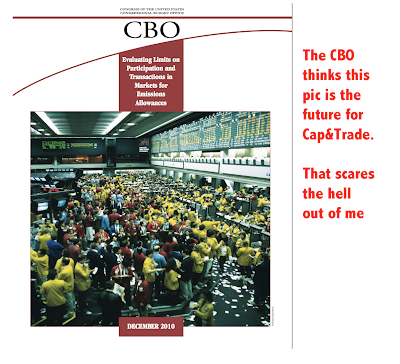What to do with carbon based emissions? I have no clue. I’m not sure Congress does either. They will be more confused than ever after reading a recent CBO report on the topic.
In theory, the Cap&Trade approach is simple. A market will be formed. There are two classes of participants. Those that produce carbon based emissions, and those that don’t. The government will intervene and provide a floor price (a cost to produce carbon based energy). The government will also provide a ceiling (to insure that the cost of this is not too expensive). Finally, the government will provide “allowances” to certain green participants. Those allowances can be sold for cash in the ‘market’.
Wait a second. Hold on. There is nothing close to being ‘simple’ about this. The government is going to be on the buy-side and on the sell-side at the same time and they are going to be handing out allowances that are worth money? What the hell kind of plan is that? It gets better. Consider the following slide from the CBO on the theoretical size of the Cap and Trade market:
Note that the estimate for the buy side of Cap and Trade is between 70-80b. A very big number. It is 6Xs the wheat market. It is a bit smaller than Nat Gas. It is equal to the combined soybean and corn turnover. It is 60% of the action in the 30-year bond.
Wheat, corn, gas and the long bond are MONSTER markets. There are 100rds of thousands of participants. There is billions of equity money behind these markets. Under most conditions they are highly efficient. They allow for a high degree of price discovery. Most importantly, the efficiency of these markets is dependent on an extremely high usage of derivatives. Note that the corn/soy primary market of b produces a combined exchange traded and OTC derivatives total of Trillion. Based on the CBO data the ratio of primary to derivatives is 125 to 1.
The CBO looks at this and correctly concludes that a market this big has it’s own systemic risks:
For example, a rapid increase in allowance prices could raise electricity prices, which would harm U.S. businesses that rely on electricity. The risk of cascading disruptions from the market for a single asset, such as allowances, to other markets and possibly the entire U.S. economy is calledsystemic risk.
So to address the systemic risks what are the suggestions?
Prohibition on Traders
BK: Dumb idea. Without traders there is no liquidity and then it becomes a government bucket shop. The worry is that there will be some sharpies in Chicago who make a killing off of this. But without the sharpies there is no market.
Circuit Breakers
BK: That there is a perceived need for this when the government is going to be on both sides of the market to begin with just shows how worried these folks are.
Prohibition on Derivatives
BK: Dumb idea. There will be no market without derivatives. Can’t and won’t happen.
Reliance on Centralized Clearing
BK: Anything that can be traded on an exchange can also be traded “upstairs” or “on the curb”. It merely requires a buyer and a seller and a willingness to settle up based on a future date price. Markets don’t work the way the CBO thinks.
Increased Regulation of Over-the-Counter Trading
BK: Accepting that Centralized Clearing is not possible; they propose new regulations. That has never worked.
Position Limits
BK: What limits? Who sets them? Does EXXON have a bigger limit than Goldman Sachs? Limits don’t work. Want an example? Just look at JPM and silver.
I am quite certain that the CBO believes that A) Cap and Trade is coming and B) that it will result in a very big market in a relatively short period of time. I draw that conclusion in part from the cover page of their report. They actually believe that the guys in the yellow coats are trading futures on “Allowances”.
The CBO provides a description of who might play in this sandbox:
Energy producers and other covered entities that would have to comply with the cap on emissions;
Great! Another profit opportunity for Exxon.
Entities that would receive allowances from the government but would not be subject to the cap;
Just who would get these allowances?
Businesses and individuals—mainly banks and investors, as well as companies that use emissions-intensive goods and services—that would trade allowances and related financial products with the first two types of participants and with each other.
Just one big happy family of traders and crooks.
Washington has no idea how markets work. They have some Utopian notion that markets can work efficiently without the bad apples like speculators and ugly things like derivatives. That they don’t understand this makes it a certainty that C&T will end badly.
-The government will lose money supporting a bastard market.
-The probability of a Goldilocks outcome is small. The extremes of either, (i) nothing is accomplished with emissions (supports too low) or (ii) too high a cost is established and the economy tanks, are just as probable as a favorable outcome.
-The only winners will be the banks, hedge funds, exchanges, specs, arbs and the derivative players. (AKA “Greater Wall Street”)
I don’t think there was ever much support for cap and trade. The last election probably killed it. But anyone still standing that thinks this is a good idea should read the CBO report. The table of contents tells it all:
Note: I have a number of articles of late based on reports from the CBO. Now another. Sorry if I am beating this horse to death. They just keeping dishing up stuff that I think is worth noticing.










